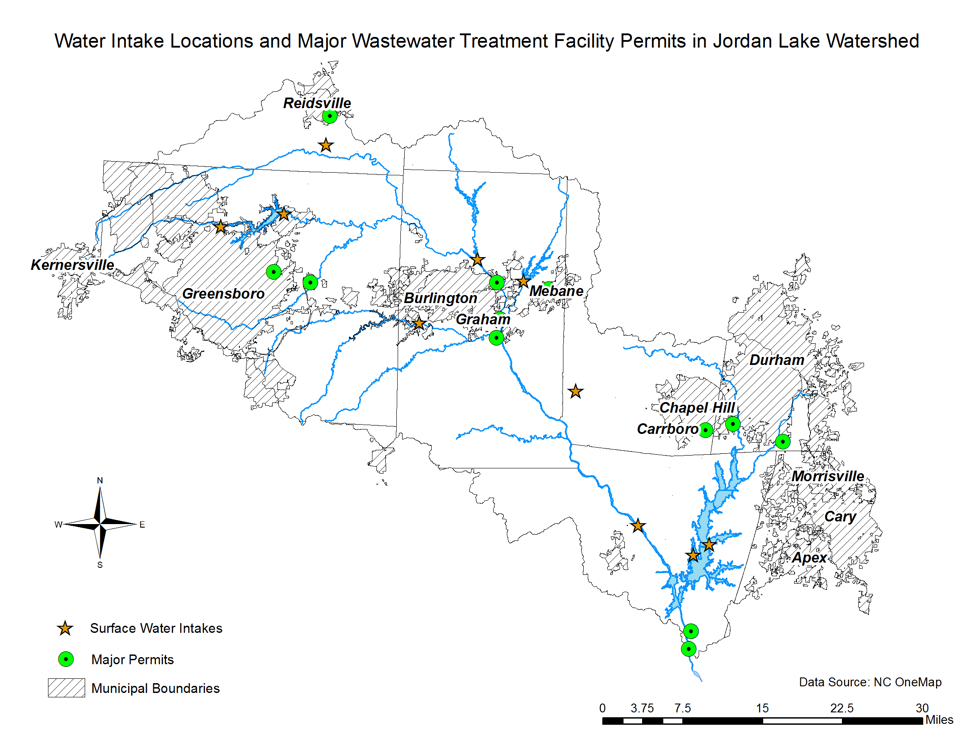Post by Erin Riggs
Erin Riggs is a Legal Advisor with the UNC Environmental Finance Center.
In 2016, the NC legislature commissioned a six-year nutrient management study to be done through the University of North Carolina at Chapel Hill (UNC), for the purpose of reevaluating the nutrient strategies for the Jordan Lake and Falls Lake watersheds.
The Environmental Finance Center (EFC) at UNC is one of more than a dozen teams working on the study, and our work is focused on the legislative directive to “review the costs and benefits of existing nutrient management strategies,” so that the state can modify such strategies in order to “share costs on an equitable basis.” The first three years of the six-year study are focused on Jordan Lake, and the last three years will be focused on Falls Lake.
Since beginning the study, the EFC has been focused on understanding the experiences and perspectives of the entities that will ultimately be responsible for implementing and paying for nutrient management strategies in Jordan Lake. In order to do that, we have been meeting with a wide variety of individuals and organizations within and outside of the Jordan Lake watershed, with our main focus being on speaking with representatives from local governments.
Although the Jordan Lake rules have gone through repeated periods of being stalled or delayed, many local governments in the Jordan Lake watershed are engaged in ongoing nutrient management and reduction practices as a result of the portions of the rules being enforced, and in anticipation of the rules which are still on hold.
In crafting our questions for meetings with local governments, we have intentionally tried to identify all potential streams of revenue that are currently going into nutrient management in Jordan Lake. Once the discussions started, it was fascinating how many costs could be attributed to nutrient management. We have identified costs directly related to wastewater treatment upgrades, voluntary stormwater retrofit projects funded in part using Clean Water Act 319 funds, agriculture cost-share programs, optimization studies, association and membership fees for Jordan Lake partnerships, monitoring fees, research studies to identify potential future retrofits for existing development, and more.

Water intake locations and major treatment facility permits in the watershed.
After just a couple initial conversations, it became apparent that there is a lot of revenue going into nutrient management, but also that it is coming from many different sources. As we continue to identify streams of revenue, and calculate the cost-effectiveness of addressing nutrient issues through such a fragmented system, we are hoping to continue to find ways:
- where revenue streams can align;
- resources can be pooled; or
- organizations can otherwise work together to increase that cost-effectiveness and make nutrient management strategies more impactful.
Now that we have a better understanding of the financial challenges in the Jordan Lake watershed, we are evaluating other regions in the country that have implemented successful nutrient management strategies to see what we can learn or borrow from them.
Right now, the nutrient management strategies are heavily focused on identification of the sources of nutrient contribution and associated regulations and limitations on such sources. But, as we move forward in investigating financing nutrient management, we recognize that we are working in tandem with teams working on the science questions, trying to delve deeper into identifying sources of nutrient loading. As part of the UNC Study scientists have deployed equipment which is collecting real time data from Jordan Lake.
Strategies and the level of involvement of local jurisdictions will be affected by what the science shows. Thus, in the event that the main source of nutrient loading is the lake itself, through legacy nutrients, the question of how to address regulating and financing nutrient management of Jordan Lake in such a situation has to be considered, as well.

